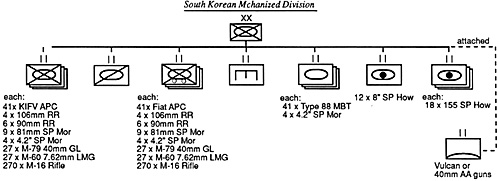 The backbone of the ROK Army is the infantry division. As shown
on the accompanying diagram, it is the basic combined arms formation,
and generally follows the organizational approach of US Army divisions
in World War II.
The backbone of the ROK Army is the infantry division. As shown
on the accompanying diagram, it is the basic combined arms formation,
and generally follows the organizational approach of US Army divisions
in World War II.
The division has limited motor transport assets, with 31 x 5-ton trucks and 375 x 2 1/2-ton trucks. In recent years, each of the division's three infantry regiments has received a fourth rifle battalion which, in peace, is staffed by a cadre and used as a training unit, and in war is fully mobilized and used for divisional rear area security duties. Similarly, many of the divisional direct support (105mm) artillery battalions have now received a fourth six-gun battery, bringing each battalion up to 24 tubes from 18. The standard piece is the US 105mm M-101 towed howitzer. Divisional medium artillery consists of a battalion of 155mm M-114 towed howitzers.
Air defense assets in a division include some javelin or Stinger hand-held SAMs, but normally an air defense unit from higher headquarters would operate in the division area, armed with towed 20mm Vulcans, 40mm 2-60/70s, 35mm CDF-003 guns, or other assorted pieces. Wider air defense is provided by Hawk and Nike Hercules SAM battalions.
Formerly, each regular infantry division had an attached tank company of 13 M-48 series tanks. Independent tank battalions were deployed as necessary. There are enough tanks now to equip each of the regular divisions with an organic tank battalion of M48-A-5s. Divisional reconnaissance battalions are light units which have included obsolete M- 8 armored cars and M-47 tanks. Each corps controls several TOW anti- tank missile companies with 18 jeep-mounted TOWs in three sections of six launchers each. These are usually distributed one to each division.
The ROK Army's two mechanized divisions are not organized along regimental lines, but have three brigade headquarters each. The nine maneuver battalions of the division (three tank, three mechanized, three motorized) can be assigned to these brigades as necessary. Divisional artillery is all self-propelled, and uses US 8-inch M-11OAl howitzers in the general support battalion and 155mm M-109A2/3 howitzers in the direct support battalions. Other division support elements are similar to the infantry division's but are more mobile.
Tank battalions in the mechanized divisions and the two independent armored brigades now use South Korea's new tank, the Type 88ROKIT (Republic of Korea Indigenous Tank). It is basically a less expensive Korean version of the M-1.
 Mechanized battalions use Korean Infantry Fighting Vehicle
(KIFV) tracked armored personnel carrier (APQ, and motorized
battalions use the Fiat 6614 wheeled APC. The 6614 has evidently not
lived up to expectations as a tactical vehicle and many have been
relegated to airfield defense roles. The up-armored KIFV carries a three-
man crew, nine riflemen, and both a .50 cal. and a 7.62mm machinegun.
Variants for the KIFV include a mortar carrier, a gun turret model
(25mm, 75mm, or 90mm), and an air defense version (Vulcan).
Mechanized battalions use Korean Infantry Fighting Vehicle
(KIFV) tracked armored personnel carrier (APQ, and motorized
battalions use the Fiat 6614 wheeled APC. The 6614 has evidently not
lived up to expectations as a tactical vehicle and many have been
relegated to airfield defense roles. The up-armored KIFV carries a three-
man crew, nine riflemen, and both a .50 cal. and a 7.62mm machinegun.
Variants for the KIFV include a mortar carrier, a gun turret model
(25mm, 75mm, or 90mm), and an air defense version (Vulcan).
Non-divisional artillery is assigned to battalions in corps artillery groups. These mainly consist of 155mm M-114 towed howitzers, but some units may be equipped with 8-inch M-115 howitzers, 155mm M- 59 guns, or 175mm M-107 self-propelled guns. Several battalions of 130mm Kooryong 36-tube multiple rocket launchers are also deployed.
Army aviation, under the 1st Aviation Brigade, employs over 250 Hughes utility helicopters for tactical lift, but must depend on US assets for medium/heavy lift. ROK armed helicopters include 50 x Hughes 500MD models with TOW anti-tank missiles and 48 AH-1 series.
Unconventional warfare units include special forces brigades and corps ranger commando regiments, both of which are lightly equipped with each brigade or regiment having about half the firepower of a regular infantry battalion. The ROK's two Marine divisions are organized generally along infantry division lines but have battalions of LVTP-7 armored amphibious APCs and M-47 or M-48 tanks attached.
The ROK Army is designed to operate on the Korean peninsula, and has evolved from the army which existed at the cease fire in 1953. Compared to the North it is distinctly light in armor, and compared to American standards it is not very well equipped with anti-armor weapons either. Reserve divisions are equipped with the same weapons as the regulars, although the scale of issue is less. Homeland reserve divisions (one per province) are equipped primarily with light and some crew-served weapons of older types, in keeping with their mission of rear area security against the unconventional warfare threat. In the future, the South Koreans are interested in greatly expanding their proportion of armored and mechanized troops.
The Units of Korea'95 The Next War in Korea
- South Korean Organization
North Korean Organization
US Army
US Marines
The Air Picture (North and South)
Back to Table of Contents: CounterAttack # 4
To CounterAttack List of Issues
To MagWeb Master Magazine List
© Copyright 1993 by Pacific Rim Publishing Company.
This article appears in MagWeb.com (Magazine Web) on the Internet World Wide Web.
Other articles from military history and related magazines are available at http://www.magweb.com